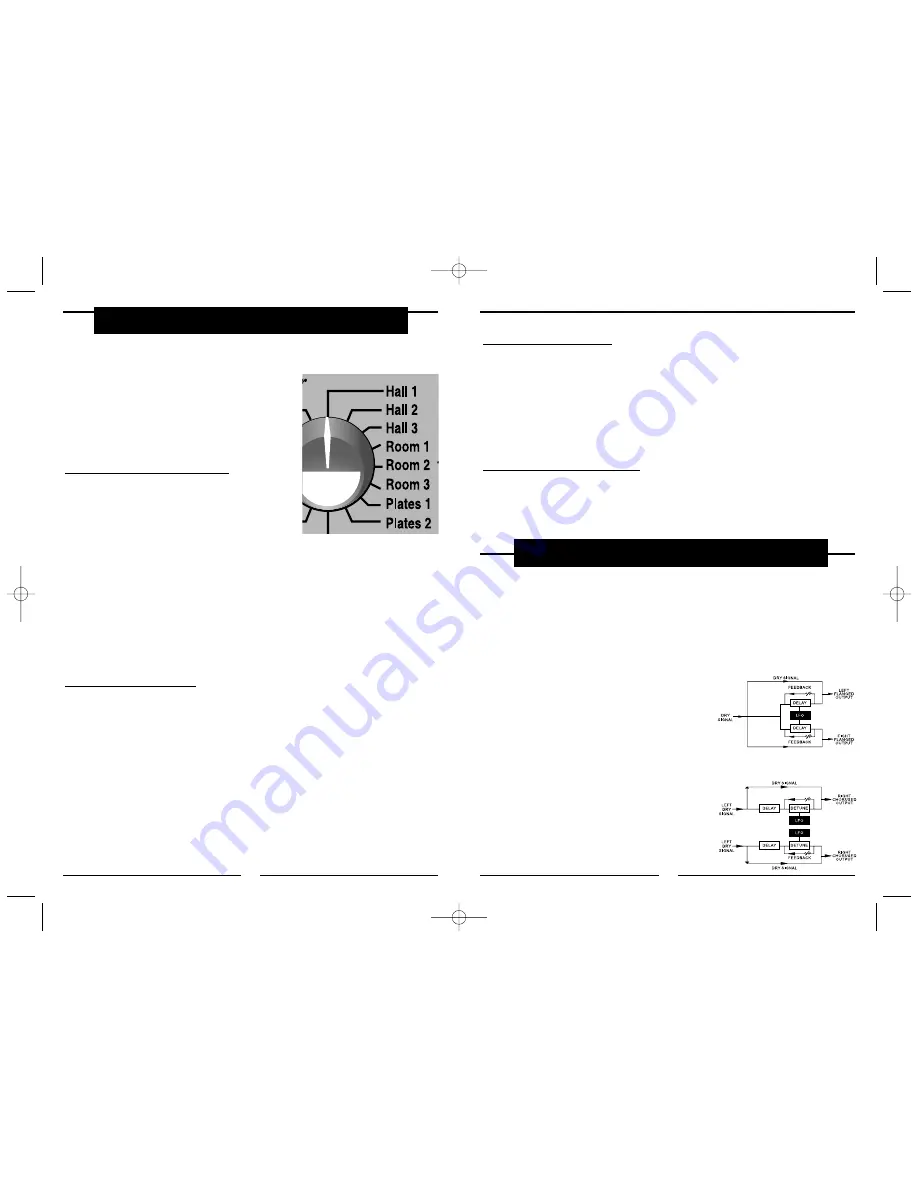
Plate Reverb (2 Programs)
This algorithm simulates a classic echo plate, typically a 4’ by 8’ suspended sheet of
metal with transducers at either end popularly used in the 70’s to produce reverb. Its
lush, transparency is ideal for the classic rock sound, especially on vocals, guitars and
piano.
• Plate 1 - A classic plate bright reverb sound particularly suited for vocals.
• Plate 2 - A warmer reverb-ideal for adding sustain on strings and acoustic guitar.
Reverb Decay Variations Adjust
The reverb decay determines how long the reverb will sound before it dies away. A
longer reverb decay simulates an increased room size. High-energy dance and rock
music usually use shorter decays, and jazz, ballads, and classical music generally utilize
longer reverb decays.
Pitched-Based Effects (5 Programs)
The DSP 256 can produce layered sounds that are far more complex than the input sig-
nal by altering its pitch and delay characteristics in several different ways. For example,
the signal can be split into two parts, the pitch of one altered and then the two mixed
back together so that the effect results from the difference between the dry original and
the wet effects signals. Generally it’s advisable to start such effect mixes at equal
strengths for these two signals by setting, for example, the MIX (8) control at 50% for
the DSP 256 on an instrument setup, or raising the effects return on a mixer.
• Flange - Flanging was originally done by intermittent-
ly slowing down one of two tape machines by applying
hand pressure against the flanges of the tape supply
reels both playing the same program in synchroniza-
tion. This resulted in the characteristic flanging “jet air-
plane” sound caused by varying phase cancellations
occurring at different frequencies. The flanging pro-
duced by the DSP 256 is specially intensified by split-
ting the signal into four parts with a stereo dry signal
and a separate delay section for both left and right
channels with one channel flanging up while the other
channel flanges down.
• Chorus - Chorusing is similar to flanging, but modu-
lates the delayed signal over a much longer delay
15
14
Program Descriptions
Reverb Effects (8 Programs)
Reverb consists of a variety of distinct echoes (reflections), each of different delay
length. Over time, each echo’s amplitude and timbre
decays according to the unique characteristics of the
acoustic space, such as sound location, distance and
reflectivity of the walls and numerous other factors. The
result is that there are many types of reverb, each with
its own sound. The following types of reverberation are
available with the DSP 256:
Concert Hall Reverb (3 Programs)
This algorithm simulates large concert halls, which are
typically large rooms with many reflective surfaces. The
complex echoes produced sound rich with a very
noticeable change in timbre as the reverb decays. A
classic versatile reverb, the Concert Hall programs
sound good on vocals, drums, and acoustic, orchestral, and electric instruments.
• Hall 1 - A large, bright hall program specially suited for vocals, guitars or drums
• Hall 2 - A warmer hall program. Select a long delay for added depth and character with
acoustic guitars and pianos.
• Hall 3 - This medium-sized hall program features a 12ms pre-delay before the reverb
starts-perfect for that extra big rock snare drum, but also great on electric guitar and all
vocals.
Room Reverb (3 Programs)
Offering the sound of a medium-size studio room, this algorithm has a bigger sound than
a hall reverb, with added punch perfect for both rock and dance music. With reflective
attack and smooth decay, the rich sound of this reverb is ideal for keyboards, drums and
guitars.
• Room 1- This reverb simulates a highly reflective studio room with a pronounced early
reflection slap-ideal for making drums sound big and enhancing acoustic instruments,
especially with the decay turned up.
• Room 2- This program is ideal on the studio for livening up dry tracks such as synths
or acoustic mixes.
• Room 3- Simulating a warm studio room, this program is perfect for acoustic guitars
and classical instruments.
DSP256manual 11/9/01 10:18 AM Page 14





























